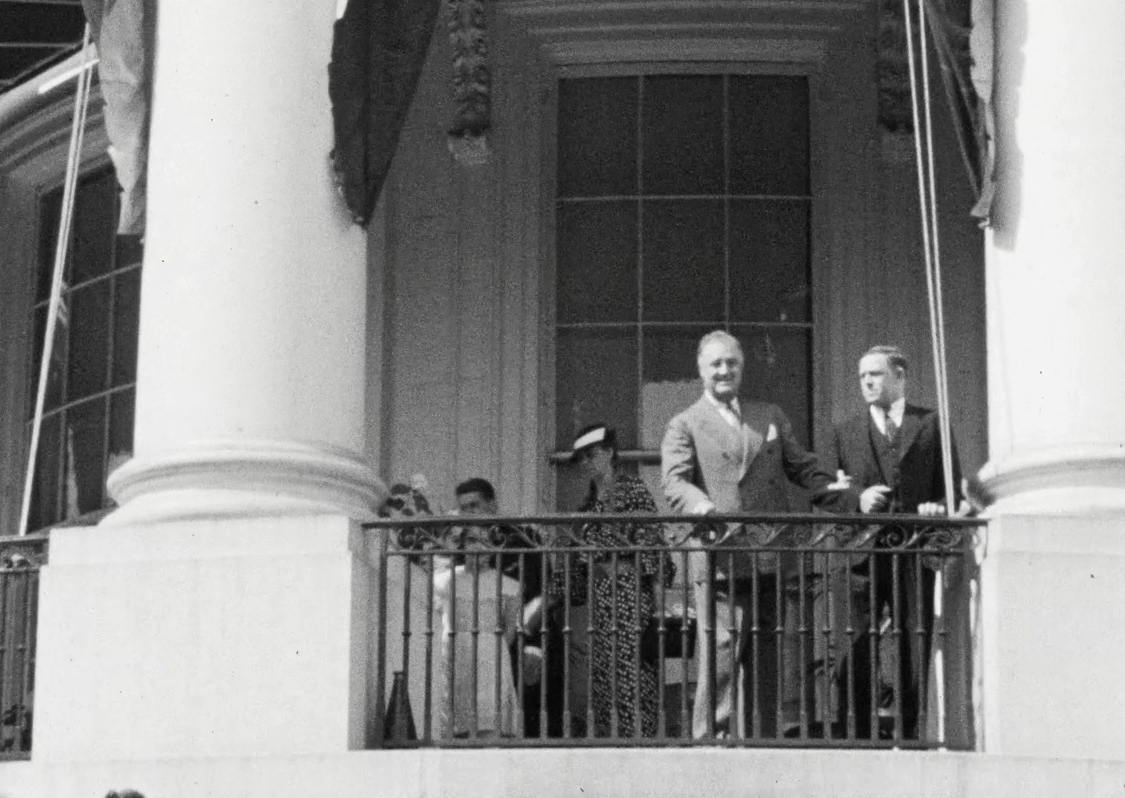 Visualització del contingut web
Visualització del contingut web
Fred Hill Film
Article by Roosevelt historian and Library Trustee, Geoffrey C. Ward
Franklin Roosevelt was elected president of the United States four times, yet most of those who voted for or against him had no idea that infantile paralysis had rendered him unable to take a single step unaided. The White House imposed strict rules on how he could be filmed or photographed: no images of FDR in his wheelchair or being helped in and out of cars were permitted; no visual record was to be made of the arduous effort it took him to move just a few steps on his rigid braced legs.
Only a handful of mostly private snapshots and a few feet of blurry amateur film hint at that struggle. But 31 seconds of silent 16 mm. amateur black-and-white footage recently deposited at the Franklin D. Roosevelt Library offer the most vivid glimpse we’ve yet had of his gallant attempt to persuade the public that he was merely “lame,” that he was vigorous enough to withstand the awful pressures of the presidency.
We owe that glimpse to a Nevada rancher named Frederick Hill. On Easter Monday, April 22, 1935 he and his wife, Marjorie and their two children attended the annual Egg Roll on the White House lawn. Mr. Hill had a movie camera with him and began filming the genial chaos – children scurrying after eggs, the Goodyear blimp dipping low above the Executive Mansion, admirers presenting Eleanor Roosevelt with baskets of flowers. The crowd was enormous: by evening, 51,391 people would pass through the White House gates – a record for the time.
Then, at some off-screen signal, three newsreel cameramen begin shouldering their way toward the South Portico. They are to wait until the President and First-Lady have made their way to a pre-selected spot along the iron railing before they begin shooting – and then to stop shooting the moment FDR starts back inside.
But Mr. Hill pushes in behind the cameramen, oblivious to the White House rules, and begins filming as soon as he spots the President in a doorway. The larger-than-usual crowd on the lawn that day may account for the fact that the Secret Service fails to see what Hill is doing; had they seen that he is filming the President in motion they would have asked him to hand over the camera and removed the film before handing it back.
 Instead, from a distance but in crystal-clear detail, we see Roosevelt proceed along the portico with the slow, rocking gait he had painstakingly developed with physiotherapists at Warm Springs, Georgia. He grips the strong right arm of his bodyguard Gus Gennerich with his left hand, leans on a cane with his right, and heaves himself forward from the hip, one unbending leg after the other, smiling and chatting all the while as though nothing whatsoever is out of the ordinary. Behind him come Eleanor and two daughters of her brother, Hall, eight-year-old Diane and six-year-old Amy Roosevelt.
Instead, from a distance but in crystal-clear detail, we see Roosevelt proceed along the portico with the slow, rocking gait he had painstakingly developed with physiotherapists at Warm Springs, Georgia. He grips the strong right arm of his bodyguard Gus Gennerich with his left hand, leans on a cane with his right, and heaves himself forward from the hip, one unbending leg after the other, smiling and chatting all the while as though nothing whatsoever is out of the ordinary. Behind him come Eleanor and two daughters of her brother, Hall, eight-year-old Diane and six-year-old Amy Roosevelt.
When FDR and the First Lady reach their assigned spots on the railing, Roosevelt grabs on with his left hand to keep himself upright while he waves to the cheering throng with his right. The delighted crowd waves back. Then, it’s time to go. The newsreel men presumably turn off their cameras, but Mr. Hill goes on shooting and we see Gus Gennerich, -- who has slipped behind the nearest pillar so that he won’t be seen on-screen -- return to the president’s side. Together, they make their halting way back inside.



